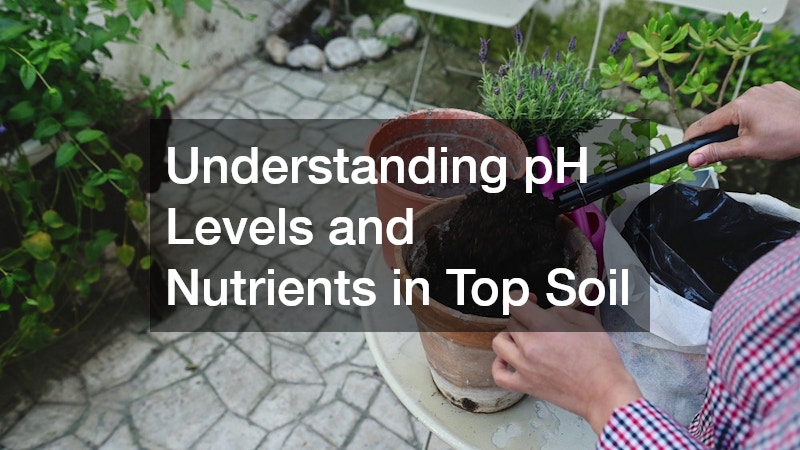
In this article, we will explore the significance of pH levels and nutrients in top soil, as well as how they impact plant health and agricultural productivity.
What is the pH Level and Why is it Important for Top Soil?
The pH level of soil indicates its acidity or alkalinity, which ranges from 0 to 14, with 7 being neutral. A pH level below 7 indicates acidity, while a level above 7 denotes alkalinity.
Understanding the specific pH level of your topsoil is essential for effective gardening and farming. This measurement has profound implications for nutrient availability and soil biology, which are crucial for plant growth. In effect, the pH level acts as a gatekeeper that either allows or hinders nutrient uptake by plants.
Different soil types can exhibit varying pH levels depending on their composition, geographical location, and organic content. For instance, sandy soils typically have a higher pH level, while clay soils can be more acidic. When the pH strays too far from the optimal range for a given plant species, this can lead to nutrient deficiencies or toxicities, impacting plant health and growth rates. Therefore, managing the pH level in topsoil is a key practice in sustainable agriculture.
In agricultural settings, monitoring and adjusting the pH level of soil can mean the difference between a fruitful harvest and a disappointing yield. Farmers often conduct soil tests to determine the pH level, enabling them to make informed decisions about soil amendments. Moreover, as climate change affects soil conditions in various regions, being vigilant about the pH level becomes increasingly important for long-term sustainability in farming practices.
How Do pH Levels Affect Nutrient Availability in Soil?
The solubility of nutrients in soil is highly influenced by its pH level. Many essential nutrients, such as nitrogen, phosphorus, and potassium, are most readily available in a slightly acidic to neutral pH range of about 6 to 7.5. When the soil pH shifts below or above this range, it can create conditions where certain nutrients become either locked up and unavailable to plants or excessively available in harmful forms. For example, high pH levels can lead to deficiencies in micronutrients like iron and manganese.
Moreover, the chemical interactions that occur at different pH levels can change the existing nutrient landscape in the soil. Certain beneficial bacteria and fungi, crucial for breaking down organic matter and facilitating nutrient uptake by plants, thrive in specific pH environments. As such, an optimal pH not only bolsters nutrient availability but also positively affects soil microbial communities, enhancing overall soil health.
Farmers and gardeners should familiarize themselves with the specific nutrient requirements of their chosen plants. Without sufficient attention to pH levels, plants may exhibit stunted growth, poor fruiting, and an array of other health issues. By understanding the relationship between pH and nutrient availability, one can foster a more productive and sustainable growing environment.
What are the Optimal pH Levels for Common Plants?
Most plants flourish in a pH range that is slightly acidic to neutral, ideally between 6.0 to 7.0. For example, leafy greens like spinach and kale thrive at a pH close to 6.0, while flowering plants like marigolds prefer a slightly higher range around 6.5. Some plants, such as blueberries, require a more acidic environment, with optimal pH levels ranging from 4.5 to 5.5. Understanding these specific preferences is crucial for achieving vigorous growth and abundant yields.
In contrast, vegetables like asparagus and carrots may not perform well in highly acidic soils, showing signs of nutrient deficiencies if the pH level dips too low. This knowledge can guide gardeners in selecting the right plants for their soil type or inform them when to take corrective measures to adjust pH levels accordingly. Consequently, matching plants with their optimal pH needs is a cornerstone of successful gardening.
How Can You Measure and Adjust pH Levels in Your Soil?
There are several reliable methods for measuring soil pH. The most straightforward is purchasing a soil pH test kit, which typically includes test strips or a sensor that provides an instant reading. Alternatively, soil samples can be processed through agricultural laboratories for more precise measurements, especially when making decisions regarding large agricultural plots. Understanding how to measure soil pH is the first step toward effective management of soil health.
Once the soil pH is determined, various methods can be employed to amend and adjust it. For acidic soils, adding lime (calcium carbonate) can raise pH levels, while sulfur or aluminum sulfate can be used to lower further alkaline soils. Organic amendments, such as compost, can also improve soil structure and usability but must be chosen carefully to avoid interfering with the soil pH. Knowing which amendments to use hinges on an understanding of both the soil’s current state and the desired outcome.
It’s vital to approach pH adjustments gradually, especially in large plots. Sudden changes can shock the soil ecosystem and compromise the health of plant life. Regular monitoring of soil pH should be an integral practice in the gardening or farming schedule, allowing for timely interventions that can make a real difference in nutrient availability and overall soil health.
Understanding pH levels and nutrient dynamics in topsoil is essential for successful gardening and farming practices, leading to healthier plants and better yields.





